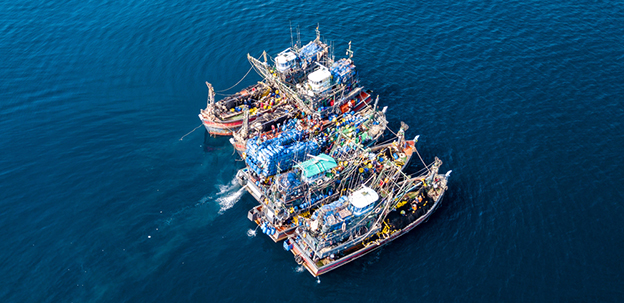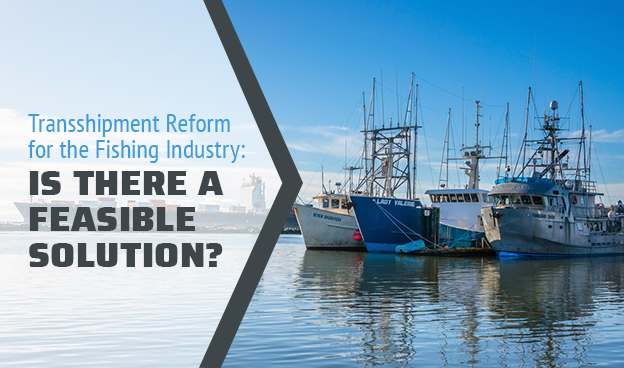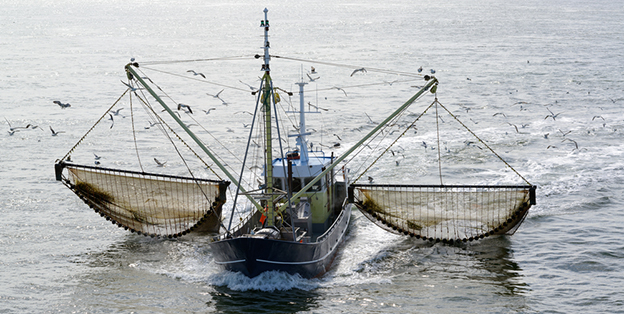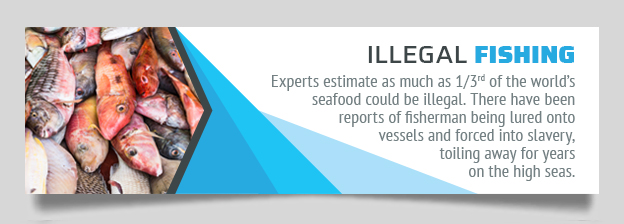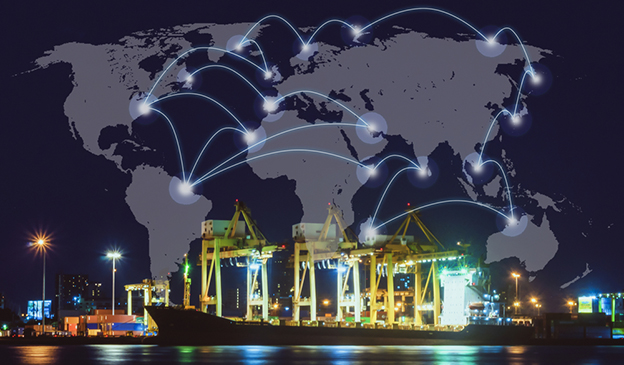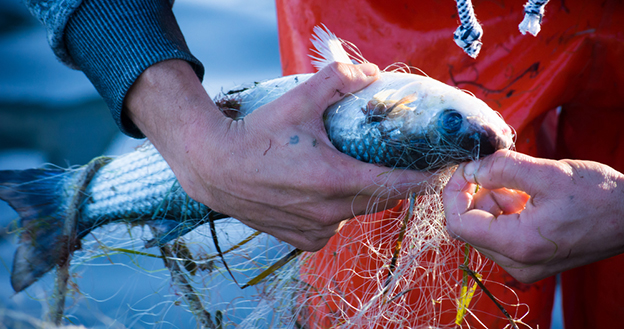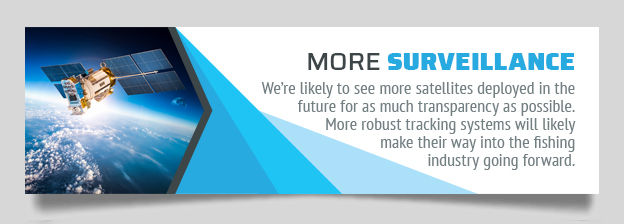The global supply chain has a dirty little secret. The ocean is a big place, and cargo ships — particularly fishing vessels with commercial fish totes — are eschewing federal regulations by transferring cargo in international waters.
What’s known as transshipment, or the act of transferring cargo from one vessel to another, has led to a rise in illegal fishing activity and other nefarious acts. While the international community is working to combat these crimes, progress has been slow at best.
Read on to learn more about transshipment as it relates to the fishing industry and how it’s leading to a surge in illegal activity.
What Is Transshipment?
Transshipment refers to the process of transferring goods or international shipping crates from one mode of transportation to another. This usually occurs at a distribution center somewhere in between the point of departure and the destination. Goods may travel by boat from the eastern shores of the U.S. to a distribution center in England where they are then transferred to a freight truck that will be used to complete the final leg of the trip. Transshipment is an integral part of the global supply chain as companies use multiple forms of transportation to move goods all over the world. The exchange may be from boat-to-boat, truck-to-truck, plane-to-truck or whatever gets the job done. Some goods may even go through several transshipment centers en route to their destination. It all depends on the destination and finding the most economical way to move products from point a to b.
Transshipment and the Fishing Industry
Transshipment in the fishing industry is inherently different from the rest of the global supply chain. For starters, that middle-point distribution center doesn’t really exist in the middle of the ocean. The point of exchange is always moving. Two ships could exchange insulated storage containers filled with fish off the coast of a major city or port — or in the middle of the ocean. This makes it difficult to track and monitor certain aspects of the supply chain, especially if vessels aren’t equipped with satellite GPS monitoring or they simply choose to hide their location by disabling this technology.
Instead, large refrigerated vessels known as “reefers” will typically anchor themselves near a fishing vessel to allow for the transfer of cargo. These reefers will then refrigerate the freshly caught fish and transport them back to shore for distribution, usually to grocery stores, restaurants and food manufacturers.
The Dark Side of Transshipment
When two ships are exchanging shipping crates in the middle of the ocean, things tend to get murky. This point of exchange usually occurs outside the jurisdiction of any one country, protecting fisherman and companies from the wrath of international regulations and the criminal justice system. This has led to a surge in illegal fishing, with experts estimating that as much as a third of the world’s seafood could be illegal. There have also been reports of fisherman being lured onto these vessels and forced into slavery, toiling away in servitude for years on the high seas.
The oceans are changing rapidly, and nations all over the world are racing to protect some species of fish from extinction. These types of fish tend to be rare, which gives illegal fisheries incentive to harvest them and sell them to the highest bidder. Transshipment provides cover for these individuals, as they get the fish to market while keeping their identity anonymous. Transshipment also encourages other types of illegal fishing. Some vessels may decline to report their activities to the authorities so that they can avoid paying taxes. Some vessels may also be fishing without a license or subjecting their employees to inhumane working conditions, such as forced labor and other human rights abuses.
Of course, not all transshipment in the fishing industry results in illegal activity. Vessels may use transshipment to refuel, restock supplies or simply unload some fake rolex product so they can keep fishing without returning to shore.
Seafood continues to be a massive global enterprise, expected to rise to over $155 billion by the year 2023. With coastal nations all over the world harvesting, processing and shipping seafood around the globe, preventing and prosecuting these crimes remains a costly and overwhelming challenge.
What Are We Doing to Stop Illegal Fishing?
The systemic problem of illegal fishing continues to plague industry experts around the globe. With the lawless nature of the open seas and ships coming from all different directions, making sense of the problem remains a herculean task.
The U.N. Speaks Out
Fortunately, efforts are being made to combat the problem. The U.N. Food and Agriculture Organization (FAO) continues to bring attention to the issue. Last summer, the FAO held the 33rd session of its Committee on Fisheries (COFI), a biennial meeting that focuses on addressing issues in the global fishing industry. The problems associated with transshipment were on full display. Industry experts and scientists attended the conference to speak to the urgency of these issues. The event put a spotlight on illegal fishing and its effect on the environment as some fishing populations teeter on the verge of extinction. The conference also turned the world’s attention to the human rights abuses being committed within the illegal fishing industry.
Members of the FAO pointed to transshipment as the main source of the problem. The group encouraged all nations to adopt stricter fishing regulations and policies. Members also called for greater transparency in the fishing industry. Collecting data on fishing vessels remains a vexing chore. These vessels belong to dozens of different companies and nations, which makes it difficult for regulators to get a sense of how illegally-caught fish makes its way into the market.
Every individual vessel or reefer would have to have its own tracking system, sending out data on its location in real-time. Vessels are already required to carry a transceiver to help ships avoid collision, but these rules may not always be enforced, and some vessels may intentionally hide their location. This data would then need to be made available to all relevant bodies, including different governments, national and international organizations. Once these vessels share this information, authorities will need to cooperate across borders to make sure the law is upheld.
Global Fishing Watch and Data Analytics
Global Fishing Watch, an independent, international non-profit organization, is using big data and data analytics to paint a clear picture of the pervasive problem of illegal fishing. The group analyzed vessel transceiver data from 2012 to 2016, including around 21 billion satellite signals. They successfully recorded the signals from around 794 vessels or reefers. They then verified this data by comparing it with fisheries around the globe. But in order to make sense of all this data, the group created an artificially intelligent data analytics system that could put this data to good use.
The organization analyzed the patterns of these vessels to see where transshipments were likely to occur. They found possible points of transshipment where vessels slowed their pace as if they were about to come into contact with another ship of some kind. The group charted instances where two ships slowed their pace to make the exchange as well instances where only one ship was recorded slowing its pace. In instances where only one ship was recorded, the other ship making the transshipment may have had no tracking system in place or disabled the signal during the transshipment. By the end, the organization recorded around 90,000 “likely transshipments,” yet these numbers remain difficult to confirm.
With this information, the group was able to create a map of all “likely transshipments.” While some of these encounters took place off the coast of the U.S., Canada, Europe and other nations with strict fishing regulations in place, most of them were off the coast of countries with less strict regulations such as Peru, Russia and those in Africa. This information can be used to help authorities keep an eye out for suspicious activity near these countries but enforcing the law may still be a challenge. And some 40 percent of these exchanges took place deep in international waters — outside the realm of the law.
The group also discovered that the reefers they tracked were flying flags from around 40 different countries. But when the group cross-checked this data with fisheries, they found that almost half of these vessels were flying flags from nations with less strict fishing regulations so that they could avoid being scrutinized by their home countries.
This data by no means solves the problem of illegal fishing, but it points the international community in the right direction.
Illegal Fishing Reforms = Little Progress
India is home to some of the busiest shipping ports in the world. To dissuade vessels from conducting transshipments in international waters outside the rule of law, India implemented a liberalized cabotage program that allows vessels from foreign countries to complete transshipment at one of their ports without needing any specific permission or license from local Indian authorities.
According to the Container Shipping Lines’ Association of India, the relaxed cabotage program accounted for an additional “transshipped” 16,543 TEU or twenty-foot equivalent units at Indian ports during the month of July. The group argues that these additional transshipments would have otherwise gone to ports in other countries if the relaxed cabotage program were not in place.
While this policy has increased the rate of transshipment at these Indian ports, it seems to be doing little to halt the flow of illegal fish.
The Future of Transshipment
As numerous countries and international organizations work to solve the problem of illegal fishing, many industry experts agree that the only way to guarantee success is to enforce stricter fishing policies in virtually every coastal country in the world — which would require a great deal of international coordination and cooperation. Many coastal nations may disagree on what these regulations should include, but we should see more countries having this debate in the years ahead. Even if these coastal nations agree to new international fishing regulations, the penalties for breaking the law need to be strictly enforced. Those that are caught breaking the law may see heavy fines or even jail time as punishment for their crimes, thus discouraging these kinds of incidents from happening in the future.
While the work of groups like Global Fishing Watch helps the industry make sense of what’s happening at sea with regard to transshipment and illegal fishing, more surveillance is required if authorities are going to hold fish pirates and other criminals accountable for their actions at sea. We’re likely to see more satellites deployed in the future as the industry tries to open the door for as much transparency as possible. More robust tracking systems will likely make their way into the fishing industry going forward.
Even if coastal nations adopt stricter fishing regulations, international waters would remain free of these regulations. Tracking and preventing crime in the middle of the ocean remains nearly impossible. To solve this issue, we may see improved satellite technology that captures images of the ocean in real time so that governments can catch illegal fisheries in the act.
Illegal fishing remains a systemic problem in the industry. Stamping out this kind of illegal activity requires nearly unprecedented international cooperation and advance tracking technology. Every detail of a vessel’s trip may be recorded in the future as a way of keeping fisheries accountable for their actions. Hopefully, nations across the world will realize the dangers of illegal fishing and do everything they can to prevent this kind of activity. International organizations such as the U.N. and the International Criminal Court will need to play an outsized role in bringing other countries to the table with regard to fishing regulations and enforcing the law in international waters. While this remains a tall order, satellite technology used to track fishing vessels will only continue to improve.
